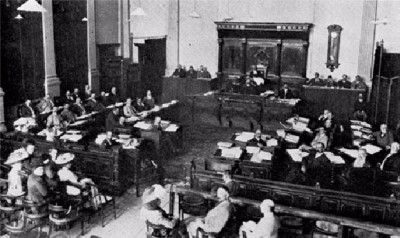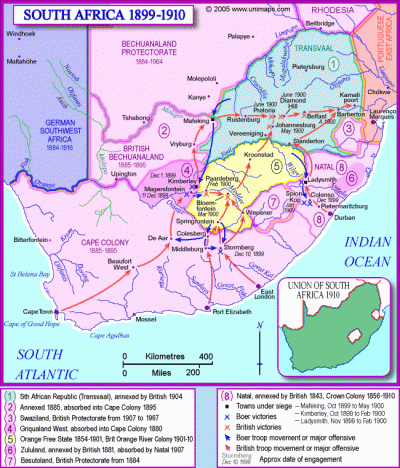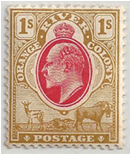ALBUM – view my Orange Free State album
TRANSITION CHART for the South Africa Area
Fast Facts
Region: Southern Africa
Group: British South Africa
Classification: British Colony
Prior Regime: Orange Free State
Key Dates:
1854, Feb 23 – Orange Free State recognized as independent Republic
1899, Oct 11 – Second Boer War breaks out
1902, May 31 – Orange Free State annexed by Great Britain to become Orange River Colony.
1907, Nov 27 – Orange River Colony achieves self government.
1909, Jan 19 – Orange River Colony renamed Orange Free State
1910, May 31 – Orange Free State (Orange River Colony) combines with Cape Colony, Natal and Transvaal to form the Union of South Africa
Following Regime: Union of South Africa
Scott Catalogue: (Orange River Colony) #55-73
Pick Catalogue: none
History

Orange Free State, was officially recognized in 1854, and built a successful republic, which was recognized by many Western European nations including Great Britain as well as the United States. The fortunes of the Republic significantly changed in 1867, when diamonds were discovered. This stimulated a rush of thousands of fortune hunters as well as keen interest from the British. By the early 1870’s, diamonds were a mainstay of the Orange Free State’s income.
 Increasingly the British were determined to bring all of South Africa, including the Boer republics under their control. Finally in October 1899 the second Boer war broke out between the Boers and the British. At first the Boers were successful but in 1900 as additional British troops arrived, British forces entered the territory of the Orange Free State and occupied the capital Bloemfontein on 13 March 1900. The British government declared an official annexation of the entire Orange Free State, on 6 Oct. 1900, dispite the fact that that British forces had not yet occupied the full territory of the republic, nor defeated the Free State forces. Over the continuing year, the Free State forces were continually pushed back, and the Boers turned to guerrilla warfare. In a sad note in British History, the British commander, Herbert Kitchener, began herding Boer women and children into concentration camps where more than 20,000 of them died of disease. The Boers surrendered in 1902, and Orange Free State was offically annexed by Great Britain with the ratification of the Treaty of Vereeniging on 31 May 1902, and the Republic ceased to exist as it became the Orange River Colony.
Increasingly the British were determined to bring all of South Africa, including the Boer republics under their control. Finally in October 1899 the second Boer war broke out between the Boers and the British. At first the Boers were successful but in 1900 as additional British troops arrived, British forces entered the territory of the Orange Free State and occupied the capital Bloemfontein on 13 March 1900. The British government declared an official annexation of the entire Orange Free State, on 6 Oct. 1900, dispite the fact that that British forces had not yet occupied the full territory of the republic, nor defeated the Free State forces. Over the continuing year, the Free State forces were continually pushed back, and the Boers turned to guerrilla warfare. In a sad note in British History, the British commander, Herbert Kitchener, began herding Boer women and children into concentration camps where more than 20,000 of them died of disease. The Boers surrendered in 1902, and Orange Free State was offically annexed by Great Britain with the ratification of the Treaty of Vereeniging on 31 May 1902, and the Republic ceased to exist as it became the Orange River Colony.
In 1904, movements began to work towards a system of self-government. With the appointment of Lord Selborne as high commissioner for South Africa and governor of the Transvaal and Orange River colonies in 1905, and the Liberal Party coming to office, this goal was within sight. Self government was achieved after the elections in 1907 on 27 November.
Even though the colony was renamed, the term Free State, remained in popular usage, even among the British. On 19 Jan. 1909, during the National Convention, a proposal that the name `Orange Free State’ be reinstated. It was unanimously approved, and the term “Orange River Colony” disappeared.
On 31 May, 1910, The British Colonies of: Orange Free State (formerly Orange River Colony), Cape Colony (Cape of Good Hope), Natal and Transvaal joined to form the Union of South Africa, a self-governing dominion of the British Empire.
Stamps
 ALBUM
ALBUM
Early in 1900, as the British began occupying the Free State’s lands, Orange Free State stamps were declared invalid, and the stamps were surcharged and overprinted “V.R.I” (Victoria Regina Imperatrix). The “V.R.I.” overprints had to be applied to postage, revenue and telegraph stamps, leading to a complex series of settings and numerous varieties.
Confident in victory, the British declared ther annexation of Orange Free State on 28 May 1900 (although they handn’t taken the lands yet). With this, in mid 1900, British authorities worked to supercede the V.R.I issues with a definitive issue bearing the portrait of Queen Victoria. However, plans had to be scrapped, following the death of the Queen in January 1901. As a result, additional Free State stamps were overprinted, as well as an additional overprint of Cape of Good Hope stamps with the words “ORANGE RIVER COLONY.” (see Orange River Colony, British Occupation)
After the completion of the war, the occupation overprints were replaced with Edwardian design stamps. In 1903, the King Edward VII design was made available in 9 denominations using paper with the Crown and CA watermark. In 1907, 4 of the denominations were reprinted on paper using the Crown and CC watermark.
In February 1905 a small number of Orange River Colony stamps were overprinted with the initials of the Central South African Railways “C.S.A.R.” specifically for their use.
Banknotes
British currency was used in Orange River Colony
Links
Orange River Colony from Wikipedia
Orange Free State Study Circle




